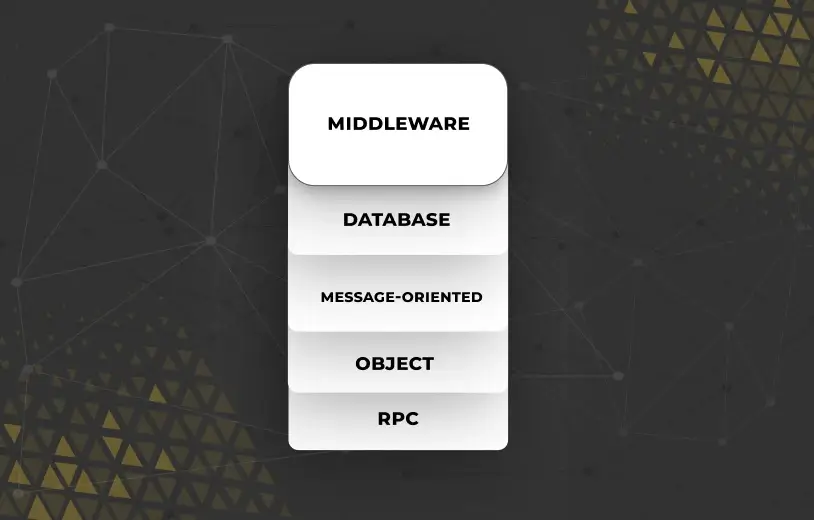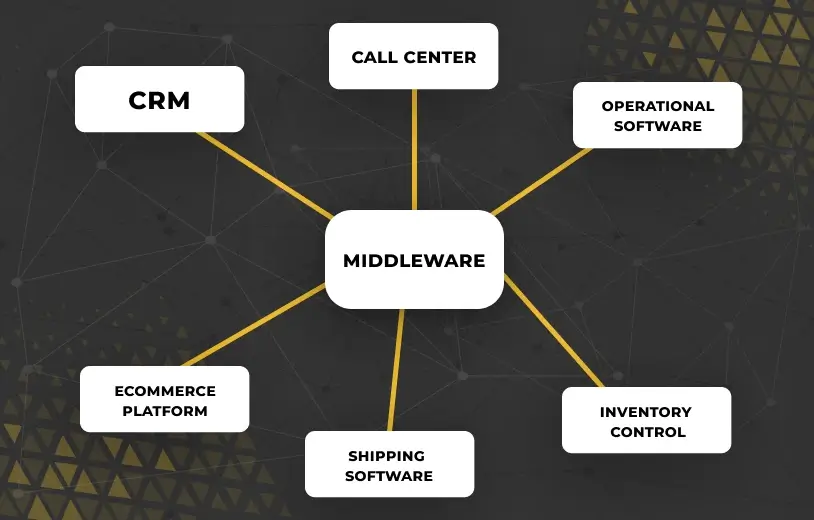Key Takeaways
- Middleware simplifies system communication, enhancing efficiency and scalability across platforms.
- Common types include database middleware, message-oriented middleware, and remote procedure call middleware.
- Selecting middleware requires consideration of compatibility, scalability, and maintenance needs.
- Early planning ensures smooth integration and adaptability to evolving business requirements.
Do you need help with outdated, bloated processes connecting your systems? Are you relying on costly development or a manual process to share data? Middleware may be the solution for you. But what is middleware?
Have you ever tied a string between two tin cans? When you spoke into one, you could hear your friend’s voice coming through the other, loud and clear. Well, for business systems, middleware is the string that helps the data flow.
Middleware is a translator that transfers important information between business systems, systems that might speak completely different languages.
Choosing the correct middleware is a decision that needs to be made early on. It needs to be done right and can grow and scale with your business.
Choosing the wrong middleware will inevitably lead to stagnation, the introduction of manual processes, or an incredibly complex and expensive upgrade project in the future.
But how do you pick the right application integrations? What’s the difference between Message Oriented and Remote Middleware? And what’s the best way to implement middleware in your business?
Below is your strategic guide to this type of software. It takes a simple and clear look at some of the main types, how they can help your business, and the steps you need to take to implement integration tools successfully.
What is Middleware?

Modern businesses with 2000 employees will use an average of 80 different systems. Each system was built by a different team of developers, and each system will manage your business data slightly differently.
Sometimes, we need these systems to take and use data from each other. Before middleware, this was a long and arduous process involving a team member spending countless hours pouring over Excel spreadsheets. Mistakes were both common and costly.
Luckily, middleware takes the weight of this process and automatically shares data between your business systems, creating a unified ecosystem. This means your staff has more time to focus on the important jobs and positively impact revenue.
Common Types of Middleware
There are several types of middleware, each designed to address specific business needs.
Understanding these differences will help you identify the right tools for your business:
Message-Oriented Middleware (MOM):
With this type of middleware, your business systems will communicate asynchronously (as in every 24 hours, for example).
It’s scalable, meaning it can handle rapid growth in customer demand, and it’s reliable, meaning that staff and customers will have a better experience.
However, due to its complexity, it can be costly. It’s not ideal for businesses that need real-time information.
This is the best middleware for eCommerce or financial platforms.
Object Middleware:
Your applications communicate by sharing self-contained packets of data using programming code.
The process is seamless, and the model allows you to reuse code across your business, reducing ongoing development costs and making it easier to add new features.
As you can expect, this can have a high initial development price tag and is prone to bloat and performance issues if not managed well (due to the sheer scale of shared data). Good maintenance and project management is a must!
This is the best middleware for IT services or telecommunications.
Remote Procedure Call (RPC) Middleware:
RPC middleware allows applications to communicate with others as if they were local, offering high performance while improving their ease of use.
This enhances development speed and the ability to provide your services to more users.
The challenge is that these systems can become highly dependent on each other, leading to a single point of failure. This option is not suitable for businesses where network reliability is an issue.
This is the best middleware for healthcare, insurers, and banking.
Database Middleware:
This type allows databases to share information, even if they’re entirely different types of databases.
It offers exceptional flexibility while reducing the cost and bloat of building different language databases throughout your software ecosystem.
The things to watch out for are poor optimization, which will slow your whole operation down, and security. One crack could expose multiple systems to breach.
This is the best middleware for inventory, shipping, or CRM.
Transaction Middleware:
Focusing on transactions rather than the code or data itself will improve your data integrity and scalability (by allowing you to confirm completed transactions or roll back if something goes wrong).
Customers trust this process, and it’s easy to scale.
However, its complexity can lead to higher initial costs and form a bottleneck, risking system-wide failures.
This is the best middleware for payments or inventory.
Portals and Embedded Middleware:
This solution provides a web interface or app to access multiple systems, including the Internet of Things (cars, fridges, doorbells, etc.).
This means you can personalize the experience of your customers or staff, significantly improving their engagement with your tools and products.
This can be expensive and requires intensive resources. There are also security risks as a single password leak could create a breach.
This is the best middleware for healthcare providers, automotive, or intranets (such as enterprise or education).
Content-Centric Middleware:
It facilitates sharing videos, documents, and audio with end-users, making it easy to scale quickly in content-heavy operations.
Naturally, these solutions are data-heavy and require a lot of bandwidth. Cataloging, version control, and tagging are essential to avoid a complex and unwieldy database.
This is the best middleware for online courses or streaming platforms.

Often, a combination of middleware may be needed to facilitate your business goals. If you’re unsure or need assistance mapping your processes, an audit by a specialized partner like
Fahrenheit Marketing can clear the way and provide a simple and optimized strategic vision.
What is the value of Middleware?
Fundamentally, middleware reduces complexity, enhances synergy between teams and systems, and minimizes manual effort in your business.
When done right, it dramatically increases efficiency and improves the experience of customers and teams. But how does it do this?
How can middleware improve efficiency?
Removing the need to create custom code between systems speeds up your development time. This leads to faster time-to-market and lower development costs, which means you can reach your revenue goals more quickly.
Can middleware scale?
Yes, it creates an ecosystem where your business tools communicate independently. This means that you can scale on demand, for example, in response to spikes in user traffic or shifts in the market. This makes your business more agile while improving cash flow and cost control.
How does middleware reduce Development Time?
By providing standardized solutions for everything from integration to security, your business can pivot quickly without jeopardizing your users’ trust or experience. This means you can capitalize on new market opportunities and launch new products with a significantly lower development time and cost.
When should you implement Middleware?

As early as possible, especially in large-scale projects involving multiple business units.
This is because teams will always need to share information. Without middleware, sharing will happen anyway, but in the wrong way – with idiosyncratic custom development or manual processes.
This will inevitably impact your ability to grow or scale. Down the line, it will become difficult to track these processes and harder still to simplify them.
Below are some crucial indicators of need to help you understand if middleware needs to be part of your initial scope:
- Project Scale and Complexity: If you are linking disparate systems that need to be standardized, managing large volumes of data or users, or looking to scale quickly, middleware is essential to include in your planning phase.
- Timing in the Development Process: Middleware is a must to standardize your communication protocols, scale with a modular approach rather than discrete custom builds, and test and troubleshoot early on.
- Flexibility and agility: Middleware is critical if your project involves high data exchange requirements, multi-channel experiences for customers and staff, or complex transactions that are likely to change as your scope and scale increase.
Challenges and Considerations
While middleware has an incredible number of advantages, it is not overstating it to say that you can only realize these by avoiding some key challenges during planning and implementation.
- Middleware is complex: Integrating diverse software systems with different languages can very difficult. Middleware is not, and should not be a one-size-fits-all solution. Challenges such as data inconsistency, performance issues, and security concerns must be planned for and resolved before they cause spiraling costs and compliance issues.
- Middleware vs. Custom Integration: In some cases, middleware may not be necessary or may be overkill for your project. For simple projects, consider a custom integration solution that removes the layers of planning and sophistication that come with middleware.
- Potential Overkill: Middleware can introduce unnecessary complexity in projects requiring more straightforward solutions. This will impact your ROI, especially if a simple solution will serve your purpose. It’s essential to assess the needs of your project with your team or a consultant so that you can choose the right level and sophistication of your integration.
What are the benefits of a middleware partner?
Partnering with a Middleware specialist gives you access to valuable, tried-and-tested resources and a predictable and transparent pricing model.
They can provide ready-made solutions that improve your time-to-market and custom solutions for niche businesses requiring very specific solutions—without the risk, uncertainty, and capital expenditure that comes with headhunting resources to do the work in-house.
Fahrenheit Marketing can help you take the sting out of your middleware projects by:
Helping you Select the Right Middleware:
With centuries of experience shared between our specialists, we can confidently assess your project requirements, map your processes, and recommend a holistic solution. This could be middleware or customer integration. We can help you understand the best option, ensuring the most efficient, effective, and quick integration for your strategy.
Optimizing your integration:
By mapping your processes in the planning stage and comparing them with your essential business outcomes, we can optimize your integration to remove bloat, enhance reliability, and improve performance while providing an exceptional experience for your customers and teams.
Customizing your Capabilities:
No two businesses are alike, and with Fahrenheit Marketing, we can keep you a step ahead of your competition by providing best-in-class integrations that are simple to use, cost-effective to maintain, and tailored to your precise and evolving business strategy.
We trust our clients, so to learn more about what we can offer, look at one of our case studies.
We have helped hundreds of businesses create an ecosystem that supports bottom-line growth, retains headcount, and provides simple, easy-to-use information for both board rooms and shareholder meetings.
Contact us today to arrange an audit of your existing software APIs and integrations to see how we can save you time and money!
